Engaging Audiences with New Forms of Interactive and Participatory Journalism
Jan Schaffer, J-Lab Executive Director: I’m Jan Schaffer, director of J-Lab, The Institute for Interactive Journalism at the University of Maryland. I used to be the Director of the Pew Center for Civic Journalism. We’re delighted to have you here today. We hope to give you a sense of some of the new kinds of journalism that are emerging that are making big use of information computer technologies to tell stories in new ways and, most important, to involve our audiences in new ways.
With us today, we have a great panel. We have Retha Hill, who is Vice President of Content Development for BET Interactive and Chief Editorial Officer of bet.com. She’s in charge of content and strategy for the content for BET, the Black Entertainment Network. This is the highest trafficked African-American site on the Internet and it was voted the best African-American community site in 2001 and 2002 by Yahoo Internet Life Magazine.
I’ve worked with Retha before in the civic journalism arena. She’s done some award-winning work with a series called Under One Roof that involved a poll on black perspectives and attitudes about things. She’s going to talk about how to get a niche market of users and viewers involved very interactively.
Mary Lou Fulton has been promoted since our program came out. She’s now publisher of northwestvoice.com and Vice President of Audience Development for the Bakersfield Californian. She has a passion for hyper-local, micro, community news and the product of that passion happened only a couple of months ago in Bakersfield, California, where she launched a so-called hyper-local citizen media site, an HLCM, called northwestvoice.com.
She developed the content management system for it. The idea behind it is to have all the content be citizen produced. She comes from being President of homepage.com, a company that delivered personal home pages. She was the Vice President of Editorial for Geo Cities in her past life. Prior to that, she was Director of Programming for aol.com. So, she’s gone from micro to macro, macro to micro, I guess.
Sreenath Sreenivasan is Associate Professor at Columbia University Graduate School of Journalism and he’s also the tech guru of WABC-TV. He teaches new media courses at Columbia. He teaches smarter web surfing workshops for journalists here in the U.S. and around the world. You can catch his show Thursdays in New York City at 6:45 a.m. or Saturdays at 7:45 a.m. He also authors the Poynter Institute’s Web Tech column, which some of you might get via a push e-mail.
Today, I’m first going to give you an overview of some of the stuff that’s emerging in a contest J-Lab runs called the Batten Awards for Innovations in Journalism . Then we’ll go to Mary Lou to talk about hyper-local, then to Retha and then to Sree.
I’d like to take questions after each panelist and while we’re taking questions, the next panelist will be hooking up their computers.
I came to participatory journalism from the civic journalism arena, which is really all about trying to figure out new ways that newsrooms could get their audiences engaged. Civic journalism evolved as a kind antidote, if you will, to some traditional media challenges that we see all around us — scorecard journalism, stenographic journalism, a focus on incremental developments, “gotcha” journalism. I would add to this list these days a focus on convergence that has taken our eyes off the prize. What we’ve seen as a result of all of this is a lot of “me-too” news. We’re just doing more of the same thing on three different platforms. We’re not particularly producing any added value.
“We lost the focus on our audiences and that’s what participatory journalism tries to restore.”
– Jan Schaffer
So, new media came on the scene and it didn’t really solve our problem because we tended to focus on things like: who got it first, what platform it was going to be on, how are we going to make money off of it, and what I call the moving parts — you know are there bells and whistles? Is there streaming audio? Is there streaming video? Are there photo galleries of some sort?
In all of this, we lost the focus on our audiences and that’s what participatory journalism tries to restore. So, you will see in all these presentations a real focus on people, on relationships, on interactions, on conversations. Journalism that’s not a lecture, but journalism that is a conversation with people. Community building and watchdogging and, more important, attachment.
I would suggest to you that if you can create the kind of
journalism that builds attachment and involvement with your audiences, you’re going to deliver to them a lot more meaningful information, in part, because they’ll have some ownership of that information.
So, what does involvement mean? This year, in particular, it means being involved and participating in the elections and in civic life through the media. That can happen through story making as well as story telling. It can happen by both constructing stories as well as deconstructing stories. Deconstructing them into their component parts. It can happen through news “experiences” as well as news stories and civic participation as well as news consumption.
“…if you can create the kind of journalism that builds attachment and involvement with your audiences, you’re going to deliver a lot more meaningful information.”
-Jan Schaffer
Think about the kinds of civic participation we’ve see through the media this year. We’ve seen e-mails of candidate actions or remarks being passed all around. We’ve seen citizen ad contests — can you produce an anti-Bush ad at MoveOn.org. We’ve seen movies being made – Fahrenheit 9/11. In all of this is, I would assert, citizens are very actively engaging in civic life, but using media forums to express that participation and, in the process, they can express their viewpoints.
In many ways they are making their own stories, making their own journalism, and I think a lot of future news is going to be about story making as well as story telling. Now, story making can be internal as well as external. Internal is consuming the stories that people make. External is making the stories people consume. Mary Lou will talk about that.
Think about how you get your news today. How many of you read a newspaper from top to bottom, everything in it? Show of hands? A few of you, but not the whole room – and you’re journalists. What we’re seeing is very much the rise of individuals as news aggregators. You may get up in the morning, you may read the front page of the paper, you look at the photos, scan the headlines, maybe the deck heads, maybe the captions. You might have NPR on when you drive to work, you might get to work and get e-mails pushed at you. Your friends may e-mail you stuff. You might have a cell phone and you might even have an RSS feed. You come home at night and maybe you turn on Jon Stewart’s “The Daily Show.” Out of all this you’re forming your own internal sensibility, or story, of the day’s events. You’re in a sense co-authoring your own news, not from the finished product we were all taught to produce in journalism school, but from these little components of news that you’re consuming all day long. So, you’re kind of making your own story out of pieces of journalism.
Now, external story making, which is what many of our panelists will talk about today, often involves citizen-created content. We’re seeing this happen in an unprecedented way in the arena of blogs, news exercises, e-mail correspondence, citizen journalists and HLCM’s, hyper-local citizen media initiatives. So, for people, it looks like future news will very much involve a process of participating in constructing the story — in the telling and in the learning and even the watchdogging.
One of my favorite hyper-local citizen sites after northwestvoice.com is New York City’s GothamGazette.com and I urge you to take a look at it. It’s a very meaty site. It’s not put out by a journalism organization; it’s put out by a nonprofit called Citizens Union. They, more than anyone else, cover local elections in depth. They cover all 51 neighborhood districts of New York City with local news. They have online Community Gazettes, where you can click on your district and find out the latest postings.
GoSkokie.com is a hyper-local site created by new media students at Northwestern University to cover Skokie, Illinois. It’s only eight weeks old right now and the challenge here will be to see if the community takes ownership of it after the grad students leave.
“…a lot of future news is really about deconstructing the story, building the components that help our users co-author the story.”
-Jan Schaffer
I think for journalists and educators, a lot of future news is really about deconstructing the story,building the components that help our users co-author the story.
And that’s going to take many forms. If it’s online, your web site will probably be not just something you read, it’s not going to be shovelware, it’s going to be something you do. You may play a game on it, you may produce the content on it, you may feedback to journalists on it, you may create a listening post for journalists. I think it may well involve what we call news “experiences” versus news stories.
Any of you who are familiar with Northwestern’s Readership Initiative know that their research shows that readers, particularly young readers, want to have news experiences — not a static session with the news, but a very interactive session with the news.
One Seattle Times reporter, after he had launched a gridlock game, said that one of his readers e-mailed him and said: “You know, I love this game. If I hear something, I often forget it. If I see it, I sort of remember it. But if I do it, if I play it, I really understand it.”
Now, what does that mean? Well we’ve had interactions before. In the past decade, civic journalists held things like town hall meetings, incredible face-to-face interactions. We had mock juries, deliberative polls and focus groups. The interactions are now coming online. So, we have online solutions reporting. This is WCPO-TV in Cincinnati, which looked at how to solve a problem with a bridge that connected Kentucky and Ohio. They invited citizens to click on one of the solutions and make donations, contribute to installing a bench or flower planters, or paint the bridge purple. This kind of involvement, online, was very easy.
A person can read a solution in a newspaper and think well, gee, that’s nice. If you read it online, where you can click on a button and say, “Wow, I can be a part of this,” it’s a very different kind of news experience. What kinds of news experiences are we seeing? Blogs, games, calculators, clickable maps, choices exercises, and various interactions.
Let’s look at blogs, which Sree will talk about in a minute. Here’s The Virginian-Pilot covering the sniper trial. Not only was a reporter inside the courtroom, but they had a reporter blogging the scene outside the trial and posting it online.
In Spokane about ten of the newspaper’s beat reporters have their own blogs and they use them to post things that may not rise to the threshold of a news story, but they’re informational tidbits that are very useful. It’s almost a reporter’s notebook online.
At the IFRA news complex at the University of South Carolina, students mobblogged the democratic presidential primary. What does that mean? They used mobile phones, they took pictures, they talked to voters, and they immediately put the photos and comments online. That’s an exercise in mobblogging. It’s very interactive and very citizen-driven.
The Dallas Morning News’ Editorial Board has its own blog and it’s really the first initiative around the country to have editorial writers be accountable to readers in terms of their opinions because readers can write back to them and say, “Why did you pick this opinion?”
This is a very simple community newspaper site at NewsZap.com where they post an article online and then right next to it they post comments.
Now, Mike Skoler from Minnesota Public Radio is in the room. He won a Batten Award last year for a state budget game that invited citizens in Minnesota to try and figure out how they could balance the budget better than their public officials. The budget calculator let you select your spending priorities. One of my favorite pieces of this exercise was a “Lookout Box” that said, “Watch it! You’ve cut $50 million here, you’re going to lay off 100,000 teachers” or something like that.
We’re seeing a lot of choices exercises with this year’s election coverage — presidential, matchmakers, vote-by-issues quizzes – which candidate issues most align with yours? This is WBUR radio’s quiz in Boston. We’re seeing electoral college calculators where you can figure out what might be the blue states, red states or yellow states in between.
Arts coverage is becoming very interactive, if any of you are arts and entertainment features writers. This was an effort also by WBUR to cover a Gauguin exhibit in town. What happens with this exercise online is you can click on any segment of this painting and you’ll hear three art experts explain it to you. So, for the first time you’re making art very accessible to the masses in a very understandable way.
GothamGazette.com has some of the best news games around and they’re 100 percent exercises in reporting. If you play their Park Game, you’ll not only figure out how to get your own neighborhood park, you’ll find out how other people have paid for it and how they got it through the system.
Now, we see real-life games. Up in the Pacific Northwest, two different news games let people pick what road projects should be built and how much the region should spend. We see trial coverage now being made interactive. This is at the Winston Salem Journal, where they covered the Darryl Hunt trial, in which DNA evidence help reverse Hunt’s conviction for killing a young woman. You click on these buttons and you can get an eyewitness view of the crime, you can read the original court documents online, and you can take a DNA test.
The spokesmanreview.com is offering multimedia obits. Reporters carry a tape recorder and talk to members of their family and then use audio software to produce an online story. They’re actually selling these now for $25 a CD. They’ve been very popular.
“…the idea is to try to think of some new entry points for our audiences. In the end our aspiration is a lot less noise and a lot more meaningful interaction.”
-Jan Schaffer
In all of this I think the idea is to try to think of some new entry points for our audiences that will build some attachments. It’s like anything else in your life, you know? If you have an attachment to something you have a relationship with something. If you have a relationship with something, the chances are you’re going to build an audience. In the end, I think our aspiration is a lot less noise and a lot more meaningful interaction.
So, that’s the grand view. You can go deeper on any of these examples. Go on www.j-lab.org, click on cool stuff or click on the Batten Award entries and you can play the games yourself
I think we’re at an interesting intersection in journalism and it’s challenging all of us to think of new ways to present information in more than a linear narrative form. This becomes particularly important as our audiences get younger, and we’re dealing with people who prefer games and multi-tasking with information. And it’s particularly important as our audiences increasingly do not have English as a primary language. If you don’t have English as your primary language, why do you want to read an English language newspaper necessarily? You may want to get your information in other ways.
So, that’s the broad, quick survey. Let me invite our panelists to go deeper on a couple of these things. Mary Lou Fulton will go first. I’ll take a question or two while she’s hooking up.
SPEAKER: Can you tell us a little bit about the Batten Awards and how do you judge for them?
MS. SCHAFFER: Interesting, the Batten Awards. We’re in the second year this year and the first year no one could quite figure out what they were about. And they’re not about moving parts, or bells and whistles. So, you may have an exquisitely produced package or a wonderful investigation that might win the Online News Association Award or it might win a Pulitzer Prize, but it won’t necessarily win a Batten Award because it’s not necessarily innovative in terms of breaking new ground.
What we’re looking for are things that not only are novel, but that engage the public in new ways. So, this year KQED won for a brand new exercise in telling more than two sides of a story called “You Decide.” And we have a point-of-view exercise from public radio that uses many digital forms to tell stories. We have a small-J exercise from the Providence Journal that lets anyone post a web page – there are now 7,000 of them — for soldiers over in Iraq. So it can be a big-J idea or a small-J idea.





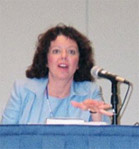 Mary Lou Fulton, Publisher, NorthwestVoice.com, Bakersfield, California
Mary Lou Fulton, Publisher, NorthwestVoice.com, Bakersfield, California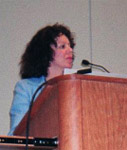 Now, one of the things that’s happening that’s good news for us is that our readers and viewers are not dropping out, they’re just sort of checking out of what we’re doing and they’re checking in to other places. And one of the places that they’re checking into is online. Now, the online content revolution is generally described as everybody’s doing e-mail and booking their flights online and all of that is true. But there’s also something else that’s happening that’s really quite amazing. There’s an explosion in creativity and in self-expression that’s happening online today.
Now, one of the things that’s happening that’s good news for us is that our readers and viewers are not dropping out, they’re just sort of checking out of what we’re doing and they’re checking in to other places. And one of the places that they’re checking into is online. Now, the online content revolution is generally described as everybody’s doing e-mail and booking their flights online and all of that is true. But there’s also something else that’s happening that’s really quite amazing. There’s an explosion in creativity and in self-expression that’s happening online today.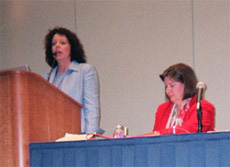 MS. FULTON: We edit primarily for grammar and spelling. Most of the things that we get are very personal in nature. So, there are people writing about something that happened to their neighbor down the street and so I don’t feel the nature of that content really requires a lot of fact checking.
MS. FULTON: We edit primarily for grammar and spelling. Most of the things that we get are very personal in nature. So, there are people writing about something that happened to their neighbor down the street and so I don’t feel the nature of that content really requires a lot of fact checking.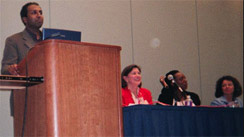 Well, folks, I’m going to talk a little bit about blogging. There are several experts on this and interactive and participatory journalism here, and I just wanted to point them out. Andrew Li who teaches in Hong Kong but was my partner in crime at Columbia University for many years, Andrew, just raise your hand there, and Paul Nemia, who teaches at Emerson is also another web genius and you should connect with them, if you can, as well. I’m sure there are other people who I know from your name and from your work, but I don’t recognize you from here.
Well, folks, I’m going to talk a little bit about blogging. There are several experts on this and interactive and participatory journalism here, and I just wanted to point them out. Andrew Li who teaches in Hong Kong but was my partner in crime at Columbia University for many years, Andrew, just raise your hand there, and Paul Nemia, who teaches at Emerson is also another web genius and you should connect with them, if you can, as well. I’m sure there are other people who I know from your name and from your work, but I don’t recognize you from here.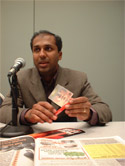 Let’s talk a little about the problems with blogs and then I’d like to take your questions and maybe get some of the folks in the audience who have done a lot of this to participate, as well. If you look at most blogs, you don’t know what is the most important thing. So, if you’re looking at a blog and the White House has been blown up, but that happened at 9:00 a.m. and it’s now 3:00 p.m., it’s not there as a top item anymore because it’s all in reverse chronological order.
Let’s talk a little about the problems with blogs and then I’d like to take your questions and maybe get some of the folks in the audience who have done a lot of this to participate, as well. If you look at most blogs, you don’t know what is the most important thing. So, if you’re looking at a blog and the White House has been blown up, but that happened at 9:00 a.m. and it’s now 3:00 p.m., it’s not there as a top item anymore because it’s all in reverse chronological order.
